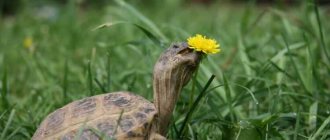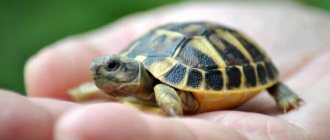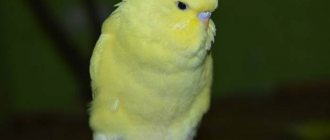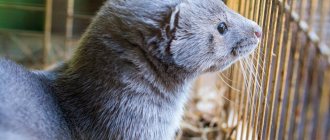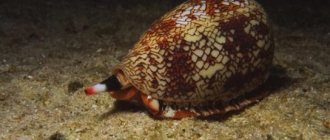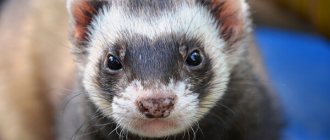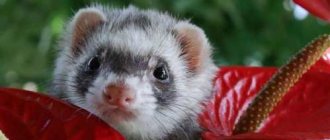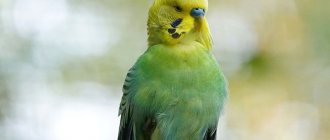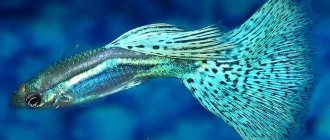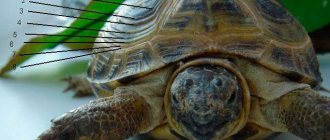Variety of species
There is no point in listing all types of land turtles or their aquatic relatives. The variety of reptile species is simply amazing. Currently, scientists believe that there are more than 300 types of reptiles. Each species is necessarily different in some way, be it the structure of the shell or the animal itself, coloring, habitat. Animal lovers often choose species of aquatic turtles to keep.
Pond slider
Perhaps the red-eared slider is the most popular reptile chosen for captivity. This turtle has a red spot located near the ears - this is how it earned its name. The red-eared turtle is an aquatic reptile, so keeping it requires a spacious aquarium. However, we should not forget about setting up a small island on which the animal will periodically go to rest.
On average, the length of the red-eared turtle is no more than 30 cm. The reptile feeds on animal food: fish fry, small fish with bones, shrimp, small crustaceans. You can give your pet insect larvae and small frogs. To diversify your diet, it’s a good idea to add plants to it. With proper care, the red-eared slider will be very active. If you plan to keep several individuals at once, then you are guaranteed to enjoy the fun games of your pets.
Central Asian tortoise
The types of land turtles are quite diverse. One of their representatives is the Central Asian tortoise. This reptile is distinguished by its slowness. The color of the turtle is beige-yellow, with black inclusions in places. The length of the animal’s shell is 20-25 cm. At the moment, this species of reptile is in the Red Book, but to this day it remains the most popular species of land turtles.
To maintain a home, prepare an enclosure for the Central Asian tortoise with a volume of at least 100 liters. There must be soil in it. It is advisable to pour a fairly large amount of sand or pebbles - land turtles love to dig holes. The reptile's diet should consist entirely of plant foods. You should not give meat to your pet. Only occasionally, as an exception, can you pamper him with insect larvae in minimal quantities.
Trionix Chinese
This type of turtle, the Chinese Trionix, is becoming increasingly popular. The main distinguishing feature of the reptile is its shell. Trionics Chinese belongs to the order of soft-bodied turtles. There are no horn plates on the carapace; it is covered with leather. However, the soft shell does not in any way prevent the reptile from showing its aggressive character.
Trionix Chinese has very powerful jaws. Although a turtle's teeth are replaced by horny plates, the bite of such a reptile can be very noticeable and lead to injury. That is why it is recommended to purchase a pet at a young age. Trionics Chinese is in the Red Book, but many pet stores ignore this and continue to sell this type of reptile.
European marsh turtle
The species of aquatic turtles suitable for home keeping are supplemented by another representative of the animal world - the European marsh turtle. Its main distinguishing feature is that both the shell and the body of the animal are painted black. Only in places you can find yellow stripes or dots, but they are very inconspicuous.
To keep a pet, you need a spacious aquaterrarium with a small island of land. The pet's diet must be balanced; the diet must include plant and animal foods.
Musk turtle
It attracts reptile lovers for several reasons. Firstly, it is rightfully considered a small representative of turtles. The length of its shell does not exceed 14 cm. Secondly, the reptile has a very interesting appearance, which is striking in its originality.
All of these are domestic turtles, the species of which are very diverse. In fact, you can keep absolutely any reptile at home, the main thing is to create suitable conditions. However, the turtles listed above are the most popular.
The types of aquatic turtles and the types of land turtles are very diverse. The world of reptiles is very interesting. If you study it, you can learn a lot of new information. For example, you might be amazed by the size of the smallest turtle. The appearance of some reptiles will also not leave you indifferent. If you want to have such a wonderful pet as a turtle, take an interest in the life of reptiles.
It is legal?
The collection of any and all turtles or certain endangered species is prohibited by law in many countries. Since 1974, the US Food and Drug Administration has banned the sale of young turtles less than 10 centimeters in length. This is due to the fact that they are carriers of the salmonella bacterium, which is dangerous to the human body, which can cause significant harm to human health.
Silt (tadheaded)
A small but very unusual turtle. The disproportionately large head and paws, combined with a small oval-shaped shell, make it look like a dwarf among the turtle people. The length is rarely more than 18 cm.
It has false teeth that can penetrate deeply when biting and cause serious damage. Therefore, it is better to admire mud turtles from a safe distance and not touch them unless necessary.
They are not as demanding on the volume of the aquarium as other types of turtles: 60-100 liters are enough for loggerhead reptiles.
It feeds mainly on raw food of animal origin. Can be fed with dry food.
Emydidae
(freshwater turtles). This is the largest family of the order, uniting more than a third of all its species. They are common to the northern continents, also found in northern South America and Africa and are very diverse in size and body shape.
The painted turtle (Chrysemys picta), which is distributed throughout the United States, is one of the most famous members of the family. It often reaches high numbers even in small ponds. Box turtles (Terrapene) are also a common genus, but are not found in the western United States. They are mostly land animals; the movable elements of the plastron enable them to tightly close all the openings of the shell, like flaps. Ornamented turtles (Pseudemys) inhabit the southeastern United States.
What you need to know before purchasing
The aquatic turtle needs not only water, but also land. The terrarium should be warm. Caring for an animal at home is not difficult; you just need to follow simple rules. It is better for a beginner to purchase a yellow-bellied breed. In winter, the reptile does not hibernate. Most of the time the reptile is in the water, so you need to take good care that the water is clean and at the required temperature. What you need to know before purchasing:
- Turtles are active animals and sometimes show aggression.
- When you buy a small turtle, its diameter is no more than 2 cm. But it must be taken into account that over time its size will reach more than a human palm, so the aquarium for the animal must be the right size.
How to determine the sex of a red-eared turtle
It is possible to distinguish the sex of red-eared turtles by external characteristics that are present in each individual of this species. The main differences in the gender of animals:
- Differences in shell color.
- Tail type and size.
- The color of a reptile's nose.
- The size of the animal's shell.
- Location of the cloaca.
- Head.
Claw length
The claws on the hind legs are dull in both animals. The male's is longer and sharper.
Males use their claws to secure themselves to their partners' shells during breeding.
This method does not reliably help to find out the sex, because in young reptiles the claws are not fully formed, and a mature animal wears off its manicure on hard ground.
Paws
Male reptiles have femoral spurs on their paws and small scales on their hind limbs.
Features of the shell
To determine the sex of a red-eared slider, look at the ventral part of the shell (plastron). In males it is concave, in females it is not.
The protective element of turtles of different sexes is different. The shell of males is long, in the tail part it forms the Latin letter V. In females, the shell is rounded and large, for bearing eggs. A special hole at the end is for storing.
Males have fewer female companions. There are some exceptions.
In female individuals the color of the plastron is different, in males it is blue.
Tail and cloaca
The most reliable factor in determining gender. In males, the process at the back of the body is long, and the base and tip are wide. Females are characterized by the presence of a short tail uniform in length.
The female's cloaca is located closer to the base of the tail and resembles an asterisk. The reptile's anus is wide for laying eggs. The male's cloaca looks more like a longitudinal line, which is located in the back, closer to the tip of the process.
By behavior
The female has a calm character. She rarely moves unless necessary.
Males, on the contrary, are aggressive. When breeding, they chase the female
They try to attract attention by biting the female on the neck, and also nod often
Other signs
Each type of reptile has a special iris color. Aquatic turtles of different sexes have different eye colors.
The female individual has a yellow nose. For men it is pointed and small.
The male's head is larger with a longitudinal stripe of a reddish hue, which during reproduction takes on a rich, bright color. The upper jaw is whitish in color.
A rare method is a blood test and x-rays. It is pointless to use the method before the age of seven. Males have not yet formed testes, and females have ovaries. Upon reaching puberty, a boy is identified by a blood test that shows elevated levels of testosterone. Ultrasound helps to identify a female individual during the formation of follicles.
- Sex can be recognized after puberty.
- A reliable option would be to make comparisons across multiple animals. Sometimes some signs are similar in turtles of different sexes. It is better to check pets based on several factors.
- Living conditions in animals sometimes cause hormonal imbalance. Then only a veterinarian can determine the sex.
The red-eared turtle is a very cute pet that requires a minimum of attention and care, looks great in photos and delights children with its friendliness. Therefore, owners often try to breed these reptiles by crossing them with each other. The question of determining the sex of the red-eared turtle in this case plays a very important role. However, this task is not at all easy.
, and its solution causes difficulties even for specialists.
The easiest way to do this is to compare two creatures of different sexes
.
This is clearly shown in the video
Then the differences can be seen clearly and the gender of the turtles can be most accurately determined.
Length and shape of claws
Adult males who have reached the age of five have long curved claws, pointed at the ends. While females have short claws and are not sharp at all. If you look carefully through a magnifying glass, you will notice that their ends are rounded.
This sign must be considered in conjunction with the others, since it cannot be considered completely reliable. Some turtles living in a terrarium with hard ground may simply have their claws worn down. In this case, their length and shape will change. And the male can easily be mistaken for a female.
Shell differences
Nutrition.
Turtles in general can be called omnivores, although some species prefer plant food, others animal food, and still others eat everything. A strictly specialized diet is rare. Some aquatic turtles only feed underwater. Very young individuals require daily feeding, but this is not necessary for adults. In fact, once well fed, they can go months, and possibly years, without food.
Turtles have no teeth, and the sharp edges of their jaws are capable of biting food, but not chewing it. Tough, fibrous plants are difficult for turtles to handle, and animal meat sometimes has to be torn into pieces using the claws on the front paws. Some species have horny ridges inside the mouth, which allow them to crush prey protected by hard coverings.
How to handle a reptile
Before you buy a turtle, you need to know how to handle it.
If you decide to take an animal in your arms, you need to be very careful, as the pet can slip out, go to the toilet, or show aggression. He may begin to hiss and resist. It must be remembered that the reptile has sharp claws and powerful limbs, so you should hold them with both hands. Otherwise, both the owner and the pet may suffer due to improper handling.
After the animal is released into the wild, it is necessary to wash your hands with soap, since turtles are carriers of salmonellosis, although they themselves do not suffer from it. The infection develops especially quickly in children.
Therefore, you should limit your pet’s access to the kitchen and other places where there are products intended for feeding people. You should also not wash your pet or anything related to it in the kitchen sink.
Conditions for keeping turtles at home
Here we will look at the so-called aquarium species of turtles: aquatic and semi-aquatic. Before buying any turtle, first evaluate your capabilities: unpretentious by nature, these creatures still require some effort on the part of the owner for a high-quality, long life.
Be prepared for a turtle to live between 10 and 50 years, depending on the species.
So, to keep a turtle you will need:
- spacious aquarium (volume from 100 liters);
- an ultraviolet lamp for heating the island (all turtles love warmth, bask with pleasure under the lamp, for some species this is vital; the lamp also allows the turtle to grow);
- creating an optimal living space - 2/3 of water and an island of land in 1/3 of the total area of the aquarium;
- filter for water aeration;
- quality food.
Now let's talk about the species themselves.
Lifespan.
No known vertebrate lives as long as turtles. Most of the information suggesting that their lifespan is slightly more than 50 years refers to individuals kept in captivity. Some species certainly live much longer. The Carolina box turtle (Terrapene carolina) found in Rhode Island was almost certainly 130 years old. The maximum period is considered to be approx. 150 years, but it is quite possible that the actual life expectancy of individual individuals is much longer.
Reproduction and offspring
With the onset of the mating season, adult male turtles organize traditional tournament fights and fights among themselves for the right to mate with the female. At such times, land turtles chase their opponent and try to turn him over by biting or hitting him with the front part of his shell. In fights, aquatic species prefer biting and chasing their opponents. Subsequent courtship allows the female to take the most comfortable position for mating.
Males belonging to some species are capable of making rather primitive sounds during the mating process. All known species of modern turtles are oviparous animals, so females lay eggs inside a pitcher-shaped hole dug with their hind legs and moistened with fluid secreted by the cloaca.
The hole with white spherical or elliptical eggs is filled up, and the soil is compacted using plastron blows. Sea turtles and some side-necked turtles lay eggs covered with a soft, leathery shell. The number of eggs varies among representatives of different species and can range from 1 to 200 pieces.
Many turtles lay several clutches during one season, and the incubation period, as a rule, lasts from two months to six months. An exception that takes care of its offspring is the brown turtle (Manouria emys), the females of which guard the nest with oviposition until the babies are born. Also interesting is the behavior of the Bahamian ornamented turtle (Pseudemys malonei), which digs up the oviposition and facilitates the release of the young.
How to distinguish a male from a female lizard?
There are a number of signs by which it is possible, but unfortunately not always as accurately as possible, to determine the sex of a lizard. The most important thing is that it is possible to distinguish a male lizard from a female only at sexual maturity, since sexual dimorphism in these individuals develops extremely late.
- The males of some lizard species, such as green iguanas and basilisks, have a brightly colored crest on their back and head, as well as large pores on their thighs.
- Another attribute of a “man” in lizards is spurs on their paws.
- Sex can be determined by the throat “bags”, preanal scutes, or a pair of enlarged scales just behind the cloaca that are present in some varieties.
In principle, all these methods are imperfect: if you need to find out the sex of a lizard with one hundred percent accuracy, then only a blood test for testosterone levels done in a professional veterinary clinic can help.
What if you buy a turtle?
Typically, turtles sold online are often wild-caught. And it is not possible to verify this, since it is simply impossible to distinguish a domestic turtle from one that lived in freedom.
Another big problem is releasing pet turtles back into the wild. This leads to an increase in the turtle population that is not typical for the area, which negatively affects local turtles and the ecosystem as a whole.
Capricorn and 3 other zodiac signs whose glass is always half empty
Choosing a haircut by age: how to get a haircut at 30, 40, 50, 60 years old
Matcha and seaweed: what the Japanese eat to maintain immunity during Covid-19
The most problematic species in this regard are the red-eared turtles, which are native to the Mississippi River basin.
Lizard tail. How does a lizard cast its tail?
Most lizards have an important feature: the ability to autotomy (throwing away the tail), which they are forced to use in emergency situations. Muscle contraction allows the cartilaginous formations of the vertebrae to be broken and most of the tail to be thrown away, while the blood vessels narrow and there is virtually no blood loss. For some time, the tail wriggles, distracting the enemy, and the lizard is able to avoid the attack. The reptile's tail recovers quite quickly, albeit in a slightly shortened form.
Sometimes a lizard grows back not one, but two or three tails:
What do lizards eat in the wild?
Basically, the lizard is a predator; it goes hunting early in the morning or at sunset. The main food of lizards is invertebrates: various insects (butterflies, grasshoppers, locusts, slugs, snails), as well as arachnids, worms and mollusks.
Large predators, such as monitor lizards, hunt small animals - frogs, snakes, and their own kind, and also happily eat the eggs of birds and reptiles. The Komodo dragon, the largest lizard in the world, attacks wild boar and even buffalo and deer. The moloch lizard feeds exclusively on ants, while the pink-tongued skink eats only terrestrial mollusks. Some large iguanas and skink lizards are almost entirely vegetarian, their menu consisting of ripe fruits, leaves, flowers and pollen. Lizards in nature are extremely careful and agile; they approach their intended prey furtively, and then attack with a swift dash and capture the prey in their mouths.
Diseases of the red-eared turtle
Preferring warmth, red-eared turtles contract diseases mainly associated with temperature changes. So, pets can get pneumonia. Like pneumonia in people, it can be one- or two-sided. The latter often leads to death.
You can diagnose pneumonia in a turtle yourself. The animal becomes lethargic and loses the ability to dive, although it tries to go under water. The treatment is to hold your pet over a hot chamomile decoction. The reptile must inhale the vapors. To prevent the turtle from being burned, we check the temperature of the steam at a selected distance from the cup with our hand.
When treating pneumonia in a turtle, it is important to eliminate sources of cold in its familiar environment. For some reason the animal got sick
Usually, the water in the terrarium is supercooled. Although red-eared turtles spend most of their time in the water, there are illnesses that require shellfish to be kept on land.
This applies to conjunctivitis. Red-eared cats are predisposed to it. The disease is contagious. Therefore, an individual with conjunctivitis is separated from the rest and allowed into the water only for a couple of hours a day.
Drug treatment for eye inflammation in red-eared turtles comes down to instilling an antibiotic. Human ones are suitable, for example, Diclofenac. The red-eared turtle will “open” its eyes in 3-4 days. If you start treatment at the first symptoms, a couple of days of therapy is enough.
Rickets is the 3rd typical disease of the red-eared slider. The animal's skull and other bones do not soften. The “impact” falls on the shell. By throwing calcium reserves onto the main skeleton, the body limits the supply of its “house”.
A deficiency of building material is caused by a lack of ultraviolet radiation, that is, sunlight and poor nutrition. For example, a meat diet leads to rickets. Red-eared turtles are omnivores and need not only proteins, but also fiber, fats, and carbohydrates.
An incorrect diet also provokes the development of skin diseases in red-eared turtles. The covers begin to peel off. These are symptoms of a lack of vitamins A and B. Therapy consists of eating foods rich in them. However, in order not to overdo it and provoke hypervitaminosis instead of vitamin deficiency, it is recommended to use balanced supplements from pet stores.
How to keep
So, for maintenance you will need an aquarium or terrarium for the red-eared turtle (or rather an aquaterrarium, since it needs both land and water), from 150 to 200 liters.
When you look at a small turtle, such requirements seem too high, but it will grow up and become much larger.
- Alexandrian parrot
- Why does a cat need a mustache?
- Rescue dogs
- Hypoallergenic cats
- Why does a cat need a tail?
- Chinchilla
There should be enough water so that the turtle can turn over freely in it, that is, more than the width of its shell.
You also need artificial land or an island on which the turtle will crawl out and bask.
Such an island can be bought at a pet store; they are specially made. If you decide to do it yourself, then remember that it should be a sloping climb, but one that will be comfortable for the animal to climb.
In principle, that's all that is needed from him.
You can make an island with your own hands; in nature, turtles choose snags, stones, old tires, or any debris sticking out of the water.
But, it is easier to buy a ready-made product, since it must meet certain conditions: not be toxic, be stable, have a textured surface, and not have sharp corners or burrs.
The island must occupy at least 25% of the surface of your aquaterarium and meet the following requirements:
- warming up is the main purpose of the shore for a turtle. The temperature on it should be 10 degrees higher than in the water. Too high a temperature is not good, it can lead to hyperthermia (overheating) in the turtle.
- be semi-submerged, at least one side must be submerged
- be safe so that the turtle does not get stuck between the wall of the aquarium and the shore itself
- do not release toxins when heated and in water
- be stable, since red-eared turtles are quite strong and can turn over the bank
- have a textured surface
Priming
You don’t have to use it at all, like any decor, turtles don’t need it. However, if you want the aquaterrarium to look less dull, then use only large stones.
For example, turtles can swallow gravel and die; besides, the soil makes caring for the aquarium more difficult.
Heating the shore for a turtle
In nature, turtles come ashore to warm themselves, and the same should be done for them in a home terrarium. To achieve the desired temperature of 30-35°C (on the shell), the lamp must be located above the turtle. You will need to look at the thermometer regularly to check the settings.
Be careful as placing a lamp too close can cause burns, especially if you are keeping multiple aquatic turtles as they may climb on top of each other and be closer to the heat source.
Also, do not forget that when turtles dive into the water they raise splashes, and if they hit the base they can easily destroy it, since it is hot. So the lamp for turtles should be closed from water and fumes.
In general, you can buy a suitable lamp at a pet store, especially since they are now sold in pairs with UV lamps, which are needed separately. The heating lamp, like the UV lamp, should work throughout the day, which is 10–12 hours.
Ultraviolet lamp for turtles
Proper lighting and heating are critical aspects of keeping a red-eared slider. In nature, it has enough sunlight and heat to produce all the necessary elements.
But in captivity she lacks neither warmth (we talked about it above) nor spectrum and needs special care. More precisely, UV rays, which are needed so that it can properly absorb calcium and produce B vitamins.
In the absence of a UV lamp in the terrarium, the turtle begins to poorly absorb calcium, which it needs for the normal development of its shell. The result is terrible animals, suffering from rickets, with severely curved shells.
The heating lamp, like the UV lamp, should work throughout the day, which is 10-12 hours.
Moreover, glass or plastic blocks a significant part of the rays and the UV lamp should hang above the turtle. For adult turtles, a lamp with UVB 10% is used.
Aquarium water
Since it is an aquatic species, it spends most of its time in water, so monitoring its quality is very important.
Turtles eat, sleep and defecate in the water, so it needs to be filtered and changed frequently. Dirty water is one of the sources of discomfort, disease and infection.
The minimum water level in the aquarium is such that the turtle could turn over if it suddenly finds itself on its back. That is, no less than the width of its shell.
However, if possible, you should keep it higher, since the more water, the more stable it is and the cleaner it remains. In this case, the turtle must have free access to the shore; it must be able to climb onto it and warm itself at any time.
The water must be left for at least 24 hours so that the chlorine leaves it and it reaches room temperature.
The water temperature in an aquarium with a turtle should be 22-28°C and not fall below 20; if this is possible, then it should be heated using a heater. Be sure to use a thermometer, don't trust your feelings!
The purity of the water is very important, since turtles both eat and defecate in it. Harmful substances such as ammonia and nitrates accumulate very quickly, and the water begins to stink.
To avoid this, change the water in the aquarium once or twice a week. You can also use an internal or external filter, however, this does not replace water changes. For a turtle, internal filters are too low-power, and external filters are good, but quite expensive.
How long can a red-eared turtle live without water if it escapes from the aquarium?
For quite a long time, it happens that they run away from the aquarium and the owners find them only a few days later, lethargic, but alive. In general, she will live quietly for a day or two, but will suffer from drying out.
Hibernation of the red-eared turtle
The red-eared turtle lives in warm areas. The animal is comfortable at +35-42 degrees Celsius. Such conditions of keeping the red-eared turtle do not force it to hibernate. Simply put, prolonged sleep is a sign of an unfavorable environment for a species.
Temperatures below 10 degrees are critical. The usual room temperature for Russians does not suit pets either. We need terrariums for red-eared turtles. Only in them, under bright, warm lamps, do animals feel at ease.
If a terrarium individual hibernates, a disease is suspected. We will talk about typical ailments for red-eared turtles in a separate chapter. In the meantime, let’s take into account the possibility of improper organization of pets’ lives in the terrarium.
Firstly, turtles of the species love space. The aquarium should be low but wide. Secondly, it is difficult to determine the heating of the water. Need a thermostat. In general, we study the chapter “Secrets of caring for the red-eared turtle.”
Types of turtles
Turtle species are divided into two main types - land and freshwater. Each species includes subspecies that have distinctive features in appearance, habits and conditions of detention. If you study them all, you can easily select a suitable individual for keeping it at home.
Land species of turtles
This species includes turtles that live in steppe, arid and humid zones. Despite the fact that they are accustomed to conditions of drought and lack of water, they still require moisture for their comfortable existence; without it they simply cannot live.
Central Asian species
Reptiles of this species are clumsy. It is for this reason that they move very slowly from one place to another. This variety is considered very rare, so it is listed in the Red Book. Reptiles are prohibited from sale, but can sometimes be found for sale in some pet stores. In natural conditions, they live in the countries of Central Asia.
Main characteristics of the Central Asian turtle:
- they have a strong shell with a durable structure. It has a round shape. Its size can reach up to 20 centimeters;
- the surface of the shell is colored yellow-brown;
- the carapace has dark-colored scutes; these elements usually have an indefinite shape;
- The front paws have 4 toes.
A turtle of this species can live on average 40-50 years. This variety can be kept at home.
Galapagos tortoise (elephant)
Turtles of this species live in the Galapagos Islands. When kept in a climate with high humidity, individuals of this species acquire a round shape and also increase in body size. In arid regions, turtles, on the contrary, are quite small; the weight of males usually does not exceed 54 kilograms. In addition, they have thin and long legs.
Main characteristics of the individual:
- The length of the shell in reptiles of this species can reach up to 1.9 meters;
- the body weight of a turtle can be above 400 kilograms;
- these individuals are considered long-lived. They can live up to 170-200 years.
Mediterranean
This group of turtles, which includes about 20 subspecies. This breed can live in different regions with different climatic conditions. Reptiles of this species prefer to live in areas with increased amounts of sunlight, so they choose places with direct sunlight.
What features should you pay attention to:
- the reptile's shell has a strong structure;
- the largest size of the shell can be 35 centimeters;
- in the back of the amphibian there is horny tissue that looks like a bump;
- there are 5 toes on the front paws;
- the hind legs have the appearance of spurs.
Note! Mediterranean tortoise is suitable for home keeping
But it is important that the temperature indicator should be 25-30 degrees Celsius
Egyptian
This species primarily lives in Egypt and Israel. For her, the most important indicator is the temperature; it should be around 25-30 degrees. Reptiles have one characteristic feature - if they sense approaching danger, they immediately begin to bury themselves in the sand.
Important appearance features:
- this species has the smallest size, unlike its relatives;
- the largest shell size can be 12 centimeters;
- the surface of the shield is painted yellow, while it has a frame with a dark color;
- there are no spurs on the back of the legs.
Balkan
Turtles of this species live mainly in Southern Europe, near the sea. Amphibians that live in the western part have small body sizes, unlike individuals in the eastern part.
Appearance characteristics:
- Externally, the Balkan tortoise is similar to the Mediterranean reptile breed. But the difference lies in the size of the diameter of the shell; in individuals of this species it can be 15-20 centimeters;
- The carapace is painted in a light shade, with patches of dark color on it;
- The older the individuals, the darker the surface of the shell;
- Turtles have a spike at the end of their tail.
Balkan tortoise can be kept at home
But at the same time, one important condition must be observed - the air temperature in the place where it is kept must be within 26-32 degrees Celsius
What to feed?
Omnivores that feed on a wide variety of foods. Variety is important to keep your turtle healthy.
You can feed: artificial food, food for aquarium fish, vegetables, aquarium plants, insects, fish, invertebrates.
In addition to variety, it is important to provide a balanced diet high in calcium. Like all wild animals that live indoors, there is a tendency to overeat.
Young turtles are mostly omnivores. But as they grow and mature, they become more and more herbivorous.
Omnivorousness means that the diet contains a large amount of protein, but in adult turtles it is much less.
Turtles of any age will prefer live prey or carrion, but should only be fed occasionally. It is also necessary to provide additional calcium for the normal formation and growth of the turtle's shell.
They eat almost everything, but the main food may well be artificial food for aquatic turtles, since there are many options and types. Their composition is specially selected to provide all the necessary substances for turtles. The high protein content of commercial feeds allows them to be fed in small portions.
To make feeding more balanced, add calcium and plant foods and your turtle will be quite happy.
Please note that commercial feeds most often already contain calcium additives; read the labels on the packaging.
Red-eared turtles require water to swallow because they do not produce saliva.
They can take food on land, but will drag it into the water to eat it. You can use this to your advantage and feed them in a separate container, so the water in the aquarium will remain clean for a longer time.
Feeding with plant foods
Fresh vegetables should always be given to your turtle, regardless of whether he shows interest in them or not. A good mix of vegetables contains essential fiber, calcium, vitamins A and K.
Aquarium plants can also be given, especially since they are similar to those that the turtle has in nature.
It is especially important to feed adult and old turtles with plant foods! Their diet should consist of 75% vegetables and aquarium plants.
It can be duckweed, riccia, ludwigia, hornwort, lettuce, pieces of cucumber and zucchini, boiled dandelion and nettle, clumps of filamentous algae.
Live food (guppies, snails)
Omnivores, they happily eat everything they can get their hands on. The turtle's victims will include insects, snails, small fish and worms, crickets, etc.
So the question of whether guppies and red-eared turtles can get along in the same aquarium is not at all worth it. The same can be said about any aquarium fish, even large ones can bite.
Despite the attractiveness and availability of such foods, they should be given in moderation.
It is better to feed special food for turtles, since they are balanced and do not tolerate diseases and parasites.
How much and how often should I feed?
A difficult question, since for the most part it depends on the size, age and the food you give.
Turtles up to one year old need to be fed artificial food daily, and you can also give plant food daily, even if she refuses. But a turtle older than a year can be fed every other day or even two. However, plant foods can again be fed more often.
The amount of food may also vary. Newly hatched turtles should receive more protein, approximately 50% of the total food.
Since most turtle foods contain about 40%, you can additionally feed fish such as guppies, insects, and earthworms.
For adult turtles, the percentage of artificial food is reduced to 10-25%, and the rest should be various plants.
Since the size, shape and composition of feed can vary significantly, you need to focus on what the manufacturer writes on the packaging.
Types of lizards, names and photographs.
Scientists divide the species diversity of lizards into 6 infraorders, consisting of 37 families:
- The skink infraorder (lat. Scincomorpha) includes 7 families, which include: true lizards living in Eurasia, Africa and the USA,
- night lizards inhabiting Cuba and Central America,
- Gerrosaurs - “residents” of the Sahara and about. Madagascar,
- skinks - live everywhere, mainly in the tropics,
- Teiids - live in South and Central America,
- belted tails - live south of the Sahara and Madagascar,
- gymnophthalmids - distributed from southern Central America to southern South America.
The infraorder iguana-like (lat. Iguania) has 14 families, the most prominent representative of which is the chameleon, inhabiting Africa, Madagascar, the Middle East, Hawaii and some American states;
The gecko-like infraorder (lat. Gekkota) consists of 7 families, an interesting representative of which is the lepidoptera - legless lizards living in Australia and the islands of New Guinea;
The spindle-shaped infraorder (lat. Diploglossa) includes 2 superfamilies: shinisaurids and monitor lizards, as well as 5 families: monitor lizards, earless monitor lizards, spindle lizards, legless lizards, xenosaurs.
The infraorder vermiform lizards (lat. Dibamidae) consists of 2 genera and one family of vermiform lizards that resemble earthworms in appearance. They inhabit the forests of Indonesia, Indochina, New Guinea, the Philippines, and Mexico;
The infraorder monitor lizards (lat. Varanoidea) includes several families consisting of the largest lizards. Typical representatives are the monitor lizard, an inhabitant of Africa, Asia, Australia and New Guinea, its relative, the earless monitor lizard, an inhabitant of the island of Borneo, and the poisonous lizard, which is found in the southern states of the United States and Mexico.
The lizard suborder also includes the superfamily Shinisauroidea, which includes the genus Shinisaurus and the only species of crocodile shinisaurus (lat. Shinisaurus crocodilurus).
Pelomedusidae, Chelidae
(suborder side-necked turtles: pelomedus and snake-necked). Representatives of these two families differ in the way the neck bends when the head is pulled under the edge of the shell: if in other turtles the neck bends in a vertical plane, then in them it bends in a horizontal plane, which is explained by the special structure of the spine. Side-necks live in the Southern Hemisphere or the regions closest to it and are not found in North America, Europe and Asia. Both families unite approx. 50 types. The most bizarre of all turtles, the matamata (Chelus fimbriata) from South America, is a snake-necked turtle. Her head is covered with many outgrowths sticking out in different directions. The Australian snake-necked turtle (Chelodina longicollis) has a thin neck almost as long as its shell.
The largest lizard in the world is the Komodo dragon.
Of the existing representatives of lizards, the largest is the Komodo monitor lizard (giant Indonesian monitor lizard, Komodos monitor). Some specimens are striking in their size, reaching almost three meters in length and weighing 80-85 kg at maturity. By the way, the Guinness Book of Records includes a “dragon” from Komodo Island, which weighed 91.7 kg. These giants eagerly eat small animals - turtles, lizards, snakes, rodents, and do not disdain impressively sized prey. The Komodo dragon often feeds on wild boars, wild goats, cattle, deer or horses.
